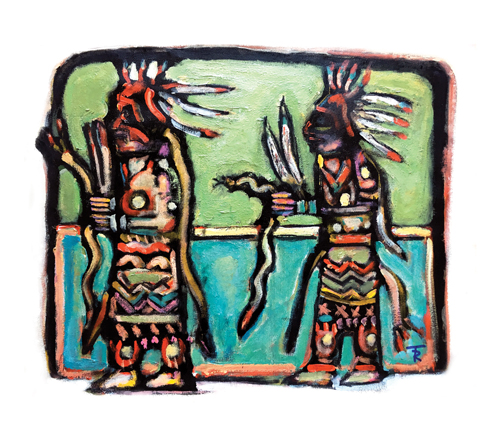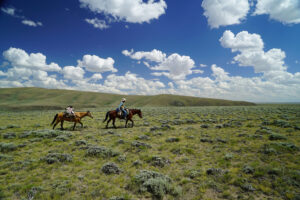The men of the Snake Clan emerge from the kiva, the round adobe building used for sacred religious ceremonies. Silently, the men walk to the plaza. There, they will pray by performing a centuries-old ritual, the most important religious ceremony of the year: the Hopi Snake Dance. Joining them are men of the Antelope Clan. A spectator describes the dancers:
The bodies of the dancers in both clans are strangely painted. Their bodies are bare from the waist up, and their faces are painted black, except for their white foreheads. They also have white paint on their forearms and their lower legs. A cluster of eagle feathers is secured in their long black hair, and some of the men wear turquoise and silver necklaces. All of them wear a dark, earth-colored kilt with a colorful band around the bottom. A finely woven rain sash hangs from their waist. Tortoiseshell rattles are fastened behind their right knee, and they wear dark brown moccasins.
The description dates from 1927. Among the major Hopi pueblos—Walpi, Oraibi, Moenkopi, Mishongnovi, Hotevilla and Shungopavi—there are some variations in costumes and procedures, but the basics have remained the same.
When two-term President Theodore Roosevelt toured the Southwest in 1913, he made certain that seeing the Snake Dance was on his itinerary.
“We were received with friendly courtesy, and that was partly due to showing good manners ourselves,” he recalled. Other outsiders were not as well behaved: “There were hundreds of onlookers the day we were there. Many of the tourists did not show the proper respect for the religious observance they were watching.”
Roosevelt was permitted to observe most of the solemn procedure, including some of the sacred preparations. “The Snake Dance represents a mystic symbolism which has in it elements that are ennobling,” he concluded.
The Hopi men traditionally perform the ceremonial dance in late August after 16 days of spiritual preparation. Gathering all the snakes they can find, especially rattlesnakes, requires four days. Young men and boys go out searching for the snakes—one morning for each direction. They keep the snakes in the kiva and prepare for the snake washing ceremony, during which a Snake priest bathes the snakes with specially prepared water. He then places the snakes on a circle of cleaned sand, where boys “herd” them together with eagle feathers. The reptiles are then placed in a kisi, a bowerlike structure of leafy cottonwood branches, about 10 feet high and 6 feet across. In front of the kisi, the men dig a shallow hole that symbolizes sipapu, the portal through which, according to Hopi legend, their ancestors emerged from deep inside Mother Earth.
When all of these preparations are complete, the ceremony can begin. In today’s world, however, most of the Hopi men have jobs and cannot take 16 days away from their work. Many villages now observe the Snake Dance only in alternate years, and it is closed to the public.
“The Snake ceremony is of such a sacred nature and was becoming so heavily exploited in past decades and became so overrun with disrespectful tourists that it was threatened with extinction,” explains Benjamin H. Nuvamsa, former chairman of the Hopi tribe. “Facing this, and coupled with the advent of easily affordable hobbyist photography, the practitioners, left with no alternative, closed the ceremonies to non-Indian spectators in approximately the 1950s.” Nuvamsa believes that non-Hopis can neither understand nor appreciate the true value of Hopi ceremonies. “The practitioners of these very sacred ceremonies,” he adds, “are forbidden to divulge to anyone, even other Hopis, the most esoteric details of the ceremonies.”
What we do know about the Snake Dance comes from reports by those permitted to see it in the past. Men of the Snake Clan dance around the perimeter of the village plaza four times. Each time around they stamp hard on the board that covers the sipapu. The dancers are telling the ancient spirits: Please take notice. The Hopis are dancing and praying today.
Following the sipapu ceremony, the Snake Clan dancers line up opposite the Antelope Clan dancers, and the men of both clans chant, their deep tones seemingly emanating from the earth. While chanting, they shake handheld rattles and sway in place. Then three Snake Clan dancers leave the line and go to the kisi.
The kisi is large enough to accommodate the gatherer, who crawls inside with all the snakes. He hands a large snake, probably a rattlesnake, to the designated carrier. That dancer clenches the writhing snake between his teeth and stands upright. The third dancer takes a position behind him and slightly to the right. He puts his left hand on the carrier’s left shoulder, and in his right hand he wields what is called a snake whip—actually just a short wooden rod with two attached eagle feathers. His task is to stroke the snake with the feathers to keep it calm.
The gatherer then emerges from the kisi and trails the other two. All the while the snake is twisting and turning, but the carrier holds it securely between his teeth. After the men complete one turn around the plaza, the carrier removes the snake from his mouth and throws it to the ground. The gatherer then collects the snake, the carrier mouths it and the trio again circles the plaza to the accompaniment of drums, rattles and chants. Meanwhile, the next group of three obtains a snake at the kisi and joins the first group on the plaza. This continues until the perimeter is lined with like trios of Snake Clan men dancing with snakes.
At that point, the snakes are placed in a large circle drawn by the priest, who now sprinkles them with corn meal. The dancers then come and scoop up their “elder brothers” and take them down to the open desert. There, they release the snakes to carry the message to the spirit world that the Hopis are living in harmony with their religious beliefs, the natural world and each other. The dancers then return to purify their bodies by drinking a greenish-brown emetic; they have not eaten for 24 hours. Thus, the ceremony ends with a fine feast.
The Hopis, especially members of the Snake Clan, wish people would stop killing rattlesnakes and other snakes. They recognize that snakes are an integral part of the natural world and that not everything on earth was placed here for the use of humans. They view snakes as messengers to the spirits of the earth from which they and all living creatures originated. Hopis believe that if they fail to live in harmony, the snakes will reject them and not serve as messengers to the spirits.
Many people mistakenly assume the ceremony is simply some type of rain dance. Instead, the Snake Dance is a means of giving thanks for a harmonious year and asking the spirits to grant future good fortune to all people, everywhere. That good fortune, of course, includes rain when needed.
Originally published in the October 2008 issue of Wild West.






